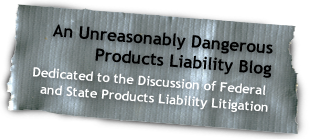Today, Abnormal Use continues its series, “Abnormal Interviews,” in which this site will conduct interviews with law professors, practitioners and makers of legal themed popular culture. For the latest installment, we turn to Charles Brownstein, Executive Director of the Comic Book Legal Defense Fund, which bills itself as “a non-profit organization dedicated to the protection of the First Amendment rights of the comics art form and its community of retailers, creators, publishers, librarians, and readers.” In so doing, it “provides legal referrals, representation, advice, assistance, and education in furtherance of these goals.” Sounds like the perfect candidate for an interview by comic-loving legal bloggers, right? Brownstein was kind enough to submit to a brief interview about the Fund and, of course, legal comics. So, without further ado, the interview is as follows:
Nick Farr: Can you begin by telling our readers a little bit about the Comic Book Legal Defense Fund?
Charles Brownstein: Sure. The Comic Book Legal Defense Fund was established in 1986 to protect the First Amendment rights of the comic book art forum. Ever since then, we’ve participated in dozens of cases providing legal support and paying for legal bills pertaining to cases involving retailers, artists and increasingly readers who are being criminally prosecuted in connection with exercising their First Amendment rights.
NF: How does the Fund decide what cases to take?
CB: The way our case selection process works is that people come to us with an aid need, and we present that need to our Board of Directors, who then will vote on the case, whether we can take it or not. The guiding principle is always whether the material – whether the case at issue is a First Amendment-based case where the comic is either being prosecuted as a result of sale or prosecuted as a result of being read or created are protected and that this is a case where the First Amendment is being violated.
NF: What percentage of the cases are criminal versus civil?
CB: I don’t have an exact percent breakdown, but the majority of our work is criminal oriented. We have done some civil defense from time to time in incidents where an artist might be civilly prosecuted by an organization that is alleging that their parody work is infringement or dilution of their rights, but those cases are fairly rare. The majority of the work that we get and the majority of the work that’s coming in frankly tends to be criminal in nature.
NF: Can you tell us about some of the successes of the Fund?
CB: Absolutely. Most recently, the Fund was leading a coalition to defend an American citizen who was being unlawfully prosecuted in Canada. When I say unlawfully, there were excesses in the arrest, and he was being prosecuted under the allegation of possession of obscene child pornography for possession of constitutionally protected comics. And thanks to our efforts in developing a very strong defense, Canada dropped the charges against this American citizen. That case is R. v. Matheson. The defendant, Mr. Ryan Matheson, is a comic reader from Minnesota. This is part of a growing generation of cases involving governments in Canada and the United States prosecuting individuals for the contents of the comics that they’re reading. As we speak, there’s a case that is pending here in the states that I can’t really speak in detail about involving an American citizen prosecuted by our law enforcement here. So that is a very concerning area because we’re seeing these laws that are designed to protect real people being misapplied to the consumers of constitutionally protected art work. Other successes of the Fund we’ve managed over our history are a variety of cases where we’ve successfully defended retailers who were being prosecuted by local law enforcement for selling constitutionally protected material and the most recent of those is Georgia v. Gordon Lee, which was a case in Rome, Georgia, where a retailer was wrongly prosecuted for allegedly distributing harmful materials to minors. It took three years and several shenanigans on behalf of the prosecutor where they threw out the facts and then refilled the facts and changed their story several times, but at the end of it we were able to successfully defend Mr. Lee who had not performed the crime that they accused him of. Most importantly, we were able to make sure that constitutionally protected material didn’t suffer a setback in court.
NF: What are some of the most egregious cases that you’ve seen through the years?
CB: Probably the – the most disconcerting case is one that happened pretty early in the Fund’s development which was Florida v. Mike Diana. This is a case involving a comic book artist in Florida who was ultimately prohibited from drawing in his own home. Mike Diana was a cartoonist that was creating comics for distribution through local stores and through the mail back in the time when there were networks of underground trading going on. He was first pulled aside by local law enforcement that found his physical description matched a suspect they were looking for in a murder investigation. When they realized that he was not the person they were looking for but had looked through his comics and were disturbed by them, they created a sting operation where one of the police officers engaged in a correspondence with Mike and ultimately purchased his comics through the mail. In doing so, that gave them the warrant to arrest him and he was prosecuted for creation and distribution of obscene material. Now, Mike’s comics are from a tradition of underground comics that were speaking of – speaking satirically in a kind of outsider art visual idiom about some of the more egregious social issues of the day. So his comics were black satire about religion and about sexual abuse and about many of the evils that were plaguing society, and he was applying an underground cartoonist editorial point of view to it. Unfortunately, in his case being brought before a jury in Florida, the jury just did not find that there was artistic merit and Mike was ultimately convicted. Despite the efforts of the Comic Book Legal Defense Fund and the efforts of the ACLU on the appeal, that conviction was upheld. And so, yes, most egregiously an American citizen was told that they were unable to draw in their own home.
NF: Once you get word of a case, do you work with local counsel or does the Fund handle the representation?
CB: The CBLDF has – our outside general counsel is Bob Corn Revere of Davis, Wright, Tremaine who’s an extremely experienced First Amendment litigator and who manages the case work that comes in. By that we mean that Bob will identify the case, make recommendations for the Board and then if we take the case, we’ll locate local counsel that is best equipped to wage the case. And then we work in a very hands-on capacity with that counsel, supervising how the work’s being done and providing them with access to our network of experts to manage the case.
NF: At Abnormal Use, we write a good deal about the depictions of lawyers and the legal system in comics. Do you have a personal favorite depiction of lawyers or the legal system in a comic?
CB: It’ll take a minute to think about. I hadn’t anticipated that. Batton Lash at Wolff and Byrd, Counselors of the Macabre is always an amusing look at lawyers and an amusing look at a variety of classic comics genres. I think that’s supernaturallaw.com is his website. And it’s hard to argue with Matt Murdock, right?
NF: Do you have any opinions on the most egregious depiction of lawyers in comics?
CB: You know, lawyers are kinda set dressing in comics. There really has never been a good literary or thriller depiction of lawyers or law, really. We’re really good at depicting fantasies about law enforcement, but we’re not so good about the other side of the law.
NF: In closing, is there anything in particular that you’d want our readers to know about the Fund that they would not have known beforehand?
CB: I think – right now we’re in the middle of an extremely disconcerting trend where readers are finding themselves vulnerable to prosecution for the contents of the art that they read. As we move into a more robust visual communications environment, this problem becomes much more serious. So the Fund is actively working to participate with folks in doing local CLE sorts of seminars where we talk about the history of our casework, and we talk about the current realm of cases. Because we feel that it’s extremely important that more individuals know their rights and it’s extremely important that more folks in the legal system or in the legal community are connected with this area of casework that’s emerging. So I strongly encourage the readers if they’re interested in helping us spread the word about these generations of cases and helping us spread the word about getting these rights into the readership community to please contact us at info@cbldf.org because that’s an increasingly important area. Ultimately, nobody should ever go to jail for reading comic books, making comic books, or selling comic books, and as the fight changes, so do we to stay on top of everything.
BIOGRAPHY: Charles Brownstein is the Executive Director of the Comic Book Legal Defense Fund. Prior to working with the Fund, he served as Programming Director for Comic-Con International in 1998 and 1999, where he developed and managed the panels and special events for Comic-Con. Brownstein is also the publisher of the award-winning interview book Eisner/Miller, and the Eisner and Harvey nominated monograph The Oddly Compelling Art of Denis Kitchen. You follow Brownstein on Twitter here.
















